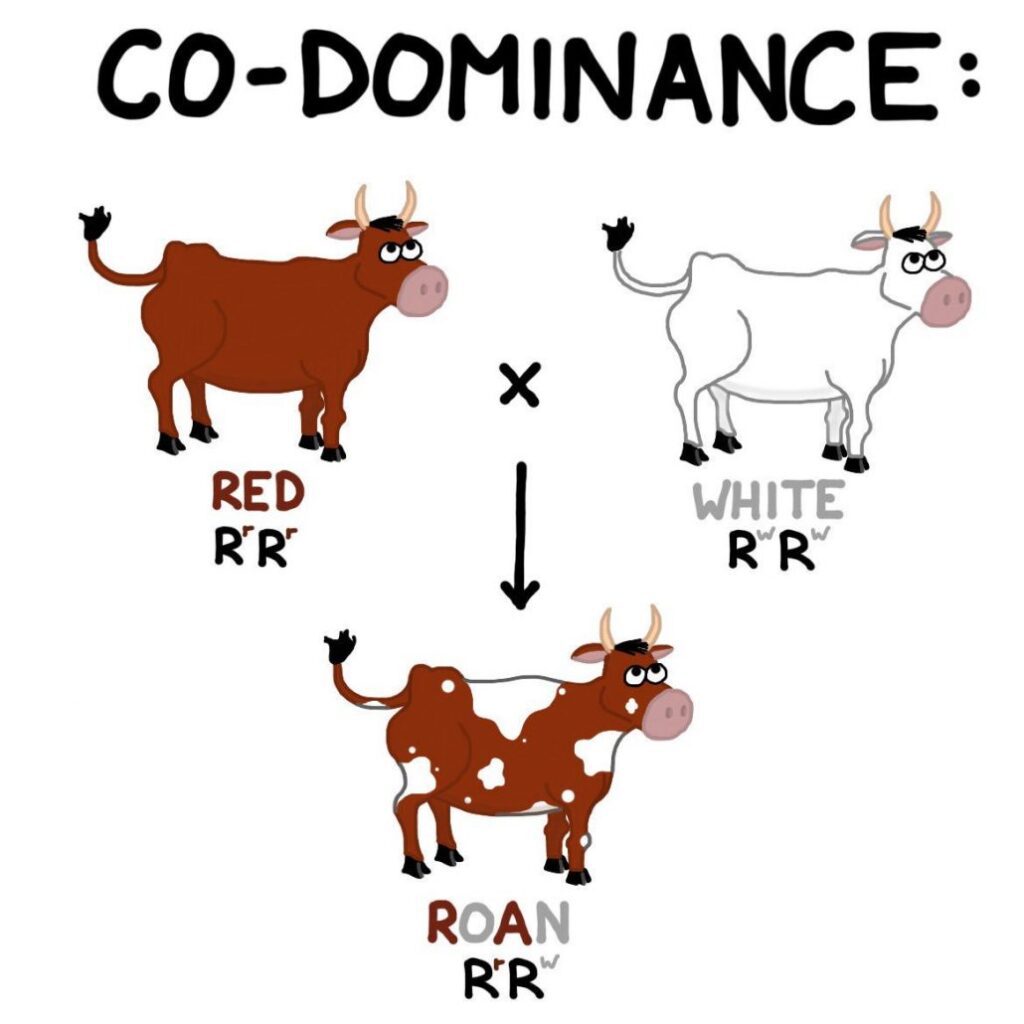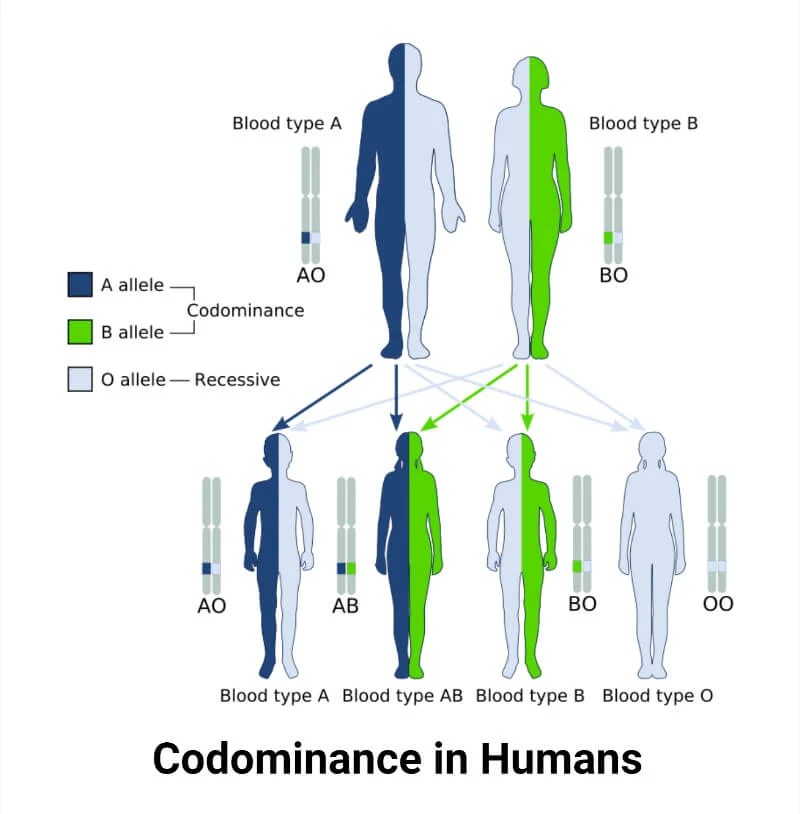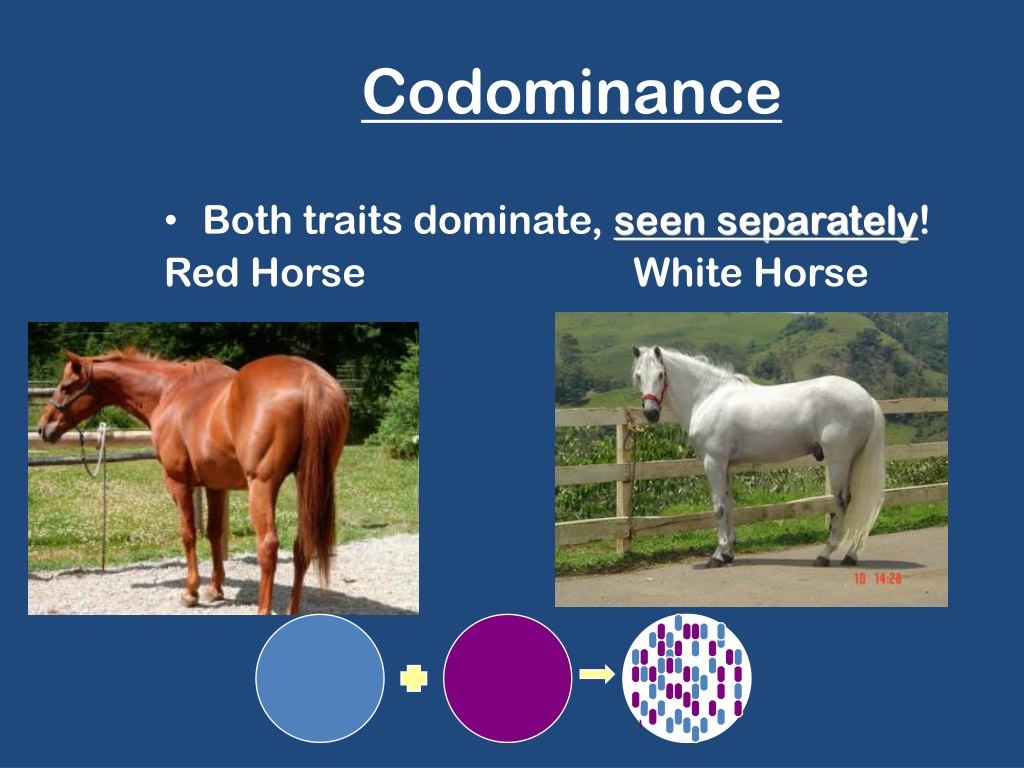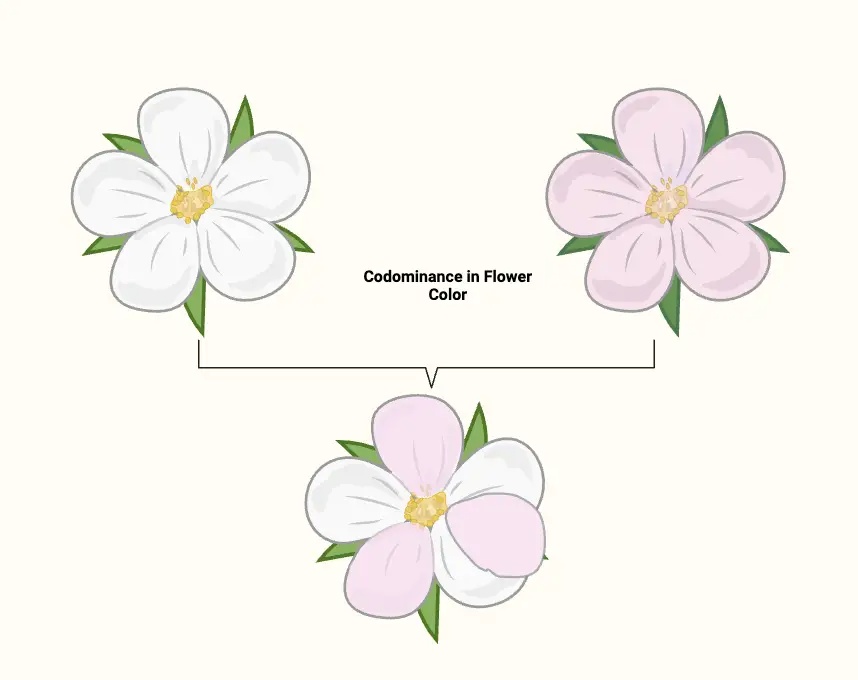Introduction to Genetics and Codominance
Codominance is a type of inheritance where both alleles in a gene pair are fully and equally expressed in the phenotype. Neither allele hides or masks the other. Instead, traits from both parents appear side by side.
Genetics is the science of heredity—how traits are passed from parents to offspring. Within the realm of genetics lies a fascinating concept called codominance, which helps explain why some offspring may show characteristics from both parents equally, rather than just one dominating the other.
Most people have heard of dominant and recessive traits. For example, if brown eyes are dominant over blue, a child with one brown-eye gene and one blue-eye gene will have brown eyes. The blue-eye gene stays hidden—recessive.
But not all traits follow that pattern. Sometimes, both genes (called alleles) show up together, side by side, without overpowering each other. This phenomenon is known as codominance.
Table of Contents
Definition of Codominance
Codominance is a form of inheritance where both alleles in a gene pair are fully and equally expressed in the phenotype (physical trait) of an organism.

In codominance:
- Neither allele is dominant or recessive.
- The traits from both alleles appear simultaneously and clearly.
- The offspring’s appearance reflects both traits without blending.
Simple Definition:
In codominance, both traits from the parents show up equally in the offspring. It’s not a mix—it’s a side-by-side expression.
Understanding with a Simple Analogy
Imagine mixing red and white paint.
- In blending (incomplete dominance): you get pink.
- In codominance: instead of blending, you see red spots and white spots—both colors appear clearly and independently.
How it Happens – The Science Behind It
Genes come in pairs—one from each parent. Each gene can have different versions (alleles). In codominance, the heterozygous condition (when two different alleles are present) results in both alleles being active.
This happens when:
- Both alleles produce functional proteins.
- The effects of both proteins are visible in the phenotype.
Unlike complete dominance (where one protein hides the other), codominance allows both proteins to function side by side.
Codominance vs. Other Genetic Patterns
| Pattern | Description | Phenotype in Heterozygote |
|---|---|---|
| Complete Dominance | One allele masks the other | Only dominant trait appears |
| Incomplete Dominance | Traits blend | A mix (e.g., red + white = pink) |
| Codominance | Both alleles are expressed equally | Both traits appear side by side |
Examples of Codominance
Let’s now explore codominance through real-life examples in humans, animals, and plants.
1. Codominance in Humans
a. AB Blood Type (Classic Example)

The ABO blood group system is a perfect example of codominance.
- Blood type is determined by the I gene, which has three alleles:
- Iᴬ → makes A antigen
- Iᴮ → makes B antigen
- i → no antigen
- Individuals with Iᴬ and Iᴮ alleles have AB blood type.
- In this case, both A and B antigens are produced equally on the surface of red blood cells.
Result: Both A and B antigens appear together—codominance.
b. Sickle Cell Trait (Codominant Expression)
- Gene for hemoglobin (Hb) has two alleles:
- Hbᴬ → Normal hemoglobin
- Hbˢ → Sickle-shaped hemoglobin
- People with HbᴬHbˢ (one normal and one sickle allele) have:
- Some normal red blood cells
- Some sickle-shaped red blood cells
Both forms are produced and visible—another codominance example.
c. MHC (Major Histocompatibility Complex) Proteins
- These proteins help the immune system recognize self vs. foreign cells.
- MHC genes are codominantly expressed, meaning you inherit and express one set from each parent, increasing immune diversity.
2. Codominance in Animals

a. Roan Coat Color in Cattle
This is a textbook example of codominance in animals.
- Red cattle (RR) have red hair
- White cattle (WW) have white hair
- Roan cattle (RW) have both red and white hairs
Result: Both red and white hairs appear equally on the body—not blended, but patches of both colors.
b. Chickens with Speckled Feathers
- Black-feathered chickens (BB)
- White-feathered chickens (WW)
- Offspring (BW) have both black and white feathers—not grey.
This pattern of feathering is clear codominance.
c. Pigeons’ Feather Patterns
Some pigeons inherit alleles for different color patterns. Instead of one pattern dominating, both patterns show up in patches across the feathers.
3. Codominance in Plants

a. Camellia Flowers (Variegated Petals)
- Some camellia plants show both red and white spots or stripes on the same petal.
- This happens when each color gene is equally expressed.
Result: Red and white are both present—classic codominance.
b. Maize (Corn) Seed Color
- A corn plant with red seeds (RR)
- A corn plant with white seeds (WW)
- Offspring (RW) shows both red and white kernels on the same ear of corn.
c. Andalusian Chickens (Although Often Incomplete Dominance)
While commonly cited as incomplete dominance (black + white = blue), some specific crosses may show feathers with black and white patches—borderline codominance.
Punnett Square for Codominance (Example: Roan Cattle)
Let’s look at a simple Punnett square:
Parents: Red (RR) x White (WW)
All Offspring: RW (Roan)
| R | R | |
|---|---|---|
| W | RW | RW |
| W | RW | RW |
All offspring show both red and white hairs—codominance in action.
Why Codominance Matters in Biology and Medicine
- Helps understand complex traits in genetic counseling
- Crucial in blood transfusions and organ transplantation
- Improves animal and crop breeding
- Essential in evolutionary biology—diversity from co-expression increases survival
Is Codominance Common?
Codominance is not as common as complete dominance, but it plays an important role in specific traits, especially in:
- Blood types
- Immune responses
- Visible coat and feather patterns
Molecular Basis of Codominance
- In codominance, both alleles are transcribed and translated into proteins.
- These proteins function independently, leading to a dual phenotype.
Example: In AB blood group, both A and B glycoproteins are expressed on red blood cells.
Codominance in Human Inheritance Counseling
Codominant traits help genetic counselors:
- Predict blood types of babies
- Explain sickle cell inheritance
- Identify organ compatibility
- Understand immune system responses
Key Differences Table
| Feature | Complete Dominance | Incomplete Dominance | Codominance |
|---|---|---|---|
| Alleles | One dominates the other | Neither dominates | Both expressed equally |
| Appearance | Only dominant trait | Blend of both traits | Side-by-side expression |
| Example | Tall vs. short peas | Pink snapdragon | AB blood type |
Conclusion
Codominance is a beautiful genetic pattern that showcases the equality of expression between two alleles. Unlike dominance, where one gene takes the spotlight, codominance allows both traits to co-exist visibly and fully. It’s nature’s way of saying: “Why choose one when you can have both?”
From blood types in humans to patchy fur in animals and colorful petals in flowers, codominance adds diversity and color to life’s genetic canvas. Understanding it not only deepens our grasp of biology but also improves applications in medicine, agriculture, and evolutionary science.
FREQUENTLY ASKED QUESTIONS
What is codominance?
Codominance is a type of inheritance where both alleles in a gene pair are fully and equally expressed in the phenotype. Neither allele hides or masks the other. Instead, traits from both parents appear side by side.
Is codominance found in animals?
Yes! Common examples include:
Roan coat in cattle: Both red and white hairs appear together.
Speckled feathers in chickens: Offspring show both black and white feathers.
Certain pigeons: Show mixed feather patterns from both parents.
What are examples of codominance in plants?
Camellia flowers: Show red and white patches on petals.
Maize (corn): Kernels with both red and white colors.
Certain snapdragons: May show distinct color zones (though often incomplete dominance is also seen).
Related Articles




